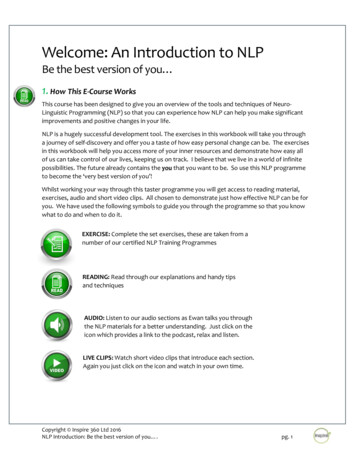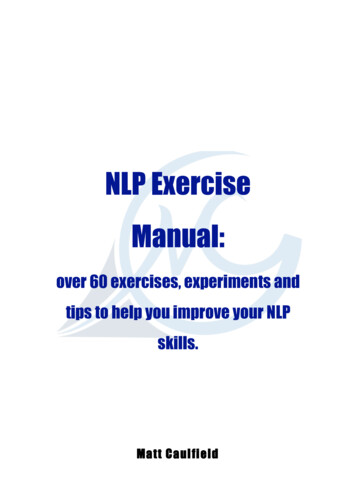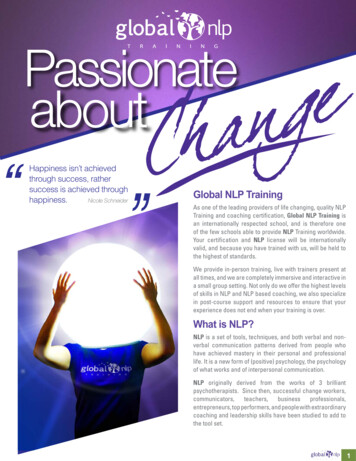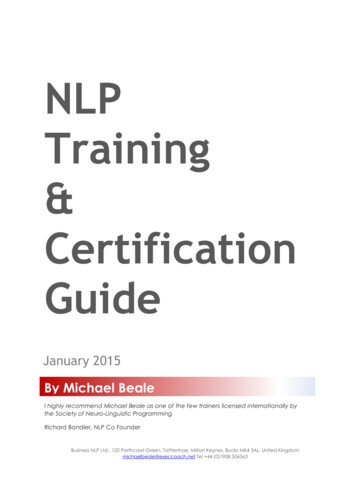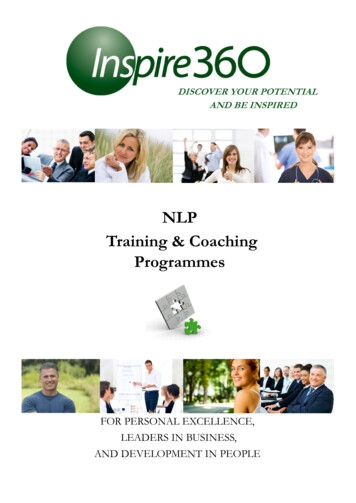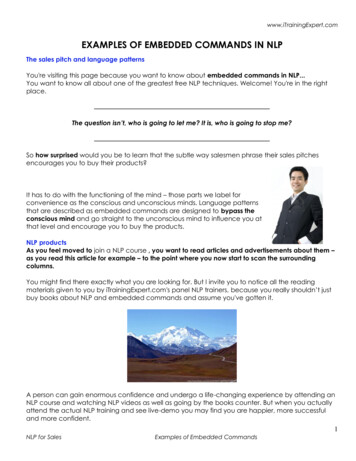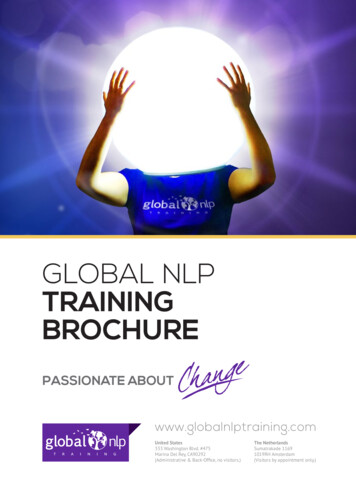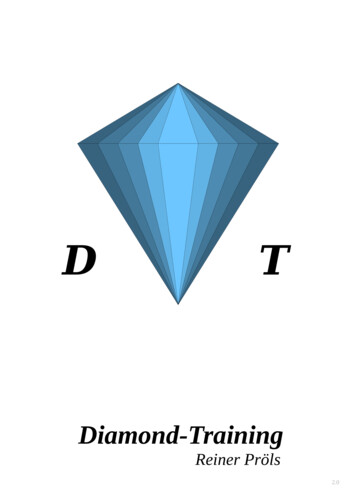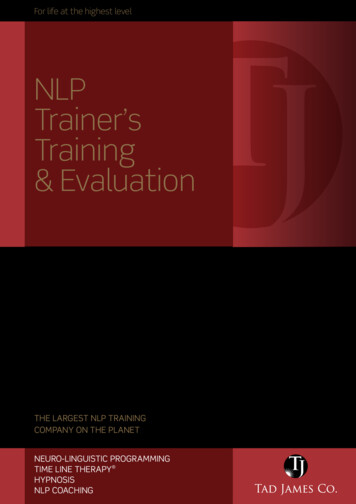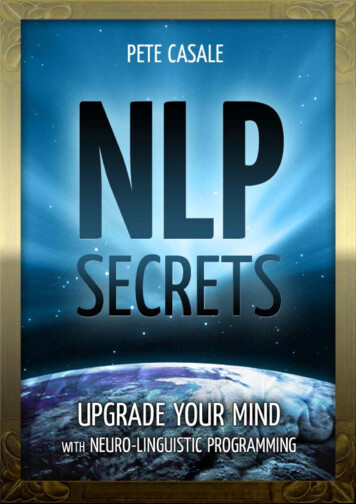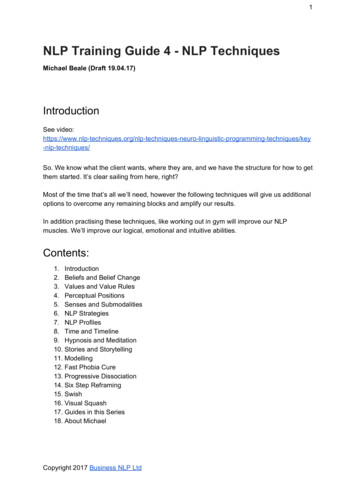
Transcription
1NLP Training Guide 4 - NLP TechniquesMichael Beale (Draft 19.04.17)IntroductionSee techniques/So. We know what the client wants, where they are, and we have the structure for how to getthem started. It’s clear sailing from here, right?Most of the time that’s all we’ll need, however the following techniques will give us additionaloptions to overcome any remaining blocks and amplify our results.In addition practising these techniques, like working out in gym will improve our NLPmuscles. We’ll improve our logical, emotional and intuitive abilities.Contents:1. Introduction2. Beliefs and Belief Change3. Values and Value Rules4. Perceptual Positions5. Senses and Submodalities6. NLP Strategies7. NLP Profiles8. Time and Timeline9. Hypnosis and Meditation10. Stories and Storytelling11. Modelling12. Fast Phobia Cure13. Progressive Dissociation14. Six Step Reframing15. Swish16. Visual Squash17. Guides in this Series18. About MichaelCopyright 2017 Business NLP Ltd
2Beliefs and Belief ChangeSee techniques/beliefs/In NLP we explore the impact of beliefs. That doesn’t mean we want to change them, onlythat we are interested in how they affect us, and we are prepared to examine and ‘try on’different beliefs to see what works best.If we believe we can, we probably will.If we believe we can’t we’re likely to not even try, or try with an attitude of apathy andreluctance.What’s so important about beliefs?Some beliefs are a mental habit, without any real-world evidence supporting them. This isnatural, and even the most sceptical-minded among us have some beliefs like that. One ofthe really interesting qualities about beliefs is that we can hold them at a deep level.We assume that they are ‘true’ and don’t realise how they are affecting what we do. We caneven hold them in such a way that we get really upset if someone dares to question them.There are two aspects of a belief to be aware of: the belief itself, andthe implications of that belief.The belief itself is normally a generalisation about someone or something.“I am always bad at job interviews.”“Senior managers don’t listen to me.”“No one from X Company will fit in here.”The implication of a belief is the effect that belief has on what we do. I can believe all sorts ofthings, but if they don’t impact me or others they’re not really relevant for this discussion.We’re not necessarily worried for now whether things are true or not, what’s more importantis the question:If the things I believe are not demonstrably true and are damaging or hindering those aroundme, why do I hold onto them?Copyright 2017 Business NLP Ltd
3NLP PresuppositionsThe co-founders of NLP discovered that the people they modelled (Milton Erickson, VirginiaSatir, and Fritz Perls), who were very successful at helping others change, had a number ofsimilar, useful beliefs. These are useful beliefs for us to adopt when helping other peopledevelop and change.We have reworded them slightly.We connect to the world through our senses.This is obvious, however the implications aren’t always thought through. We build our mapsof reality based on our sensory input. The better we see, look, hear and connect to ourfeelings, and the less we filter the information we receive, the better our maps will be. Thebetter we’ll connect and communicate with the world.Our memories are built from this sensory input. When we change some of the qualities ofthis sensory input (for example, we make our mental images more or less colourful) wechange the experience itself. This means we can learn to boost and reinforce our good anduseful memories and reduce the impact of our less useful ones.Our map is not the territory.The representation we hold of the world is our internal map based on our experiences andfilters. It is not the same as the next person’s map, and neither of them are the same asreality.When we don’t communicate with others it is not a permanent problem, it’s to do with ourmodel of the world – our maps. We communicate better when our maps are aligned withthose of other people and the world itself. The better we acknowledge the other person’smap, the more they understand us.For example, if our clients are more visual we’re better off using visual words. If they’remotivated towards pleasure, we should use some of exactly the same words and similarpostures.Even if somebody has a map that is flat out wrong, it’s often better to start from whereverthey are and then lead them to somewhere more useful.One of the benefits of exploring NLP is that we become more aware of our internal mapsand those of others.Copyright 2017 Business NLP Ltd
4The ability to change the process by which we experience reality is often morevaluable than changing the content of our experience of reality.Bad things happen. That’s the content of reality sometimes. We can’t change that contentand not accepting it can be harmful to us. However, do have some control. We can changehow we react to it. We can change what we learn from it.NLP has lots of tools we can use to change the process of how we react and act to whateverhappens.We cannot always control the cards that we are dealt; our key choice is how we play them.The meaning of the communication is the response we get.If people don’t react in the way we want, it’s a sign that we need to change the way wecommunicate. I don’t judge how successful my communication is by what I think; it’s abouthow others react.If at first I don’t get the result I want, I simply keep coming back with similar and differentapproaches until I do.The resources an individual needs for change are already within them.When we have total faith in someone it can make a huge difference on how quickly and wellthey succeed. When we believe someone has all the resources they need, it changes theway we relate to them. We’ll tend to lightly coach and encourage rather than put them down.There is a secondary point to this. The best change always starts from within, not fromoutside. Trying to change others can work, however, it normally disempowers the otherperson.Believing in someone is empowering.Feedback is always useful.We can view success and failure as inevitable parts of life. We don’t learn to walk withoutfalling over.The moment we stop making mistakes is the time we stop learning.When we fail, feedback can show a route to success instead. When we’re successful,insulating ourselves from feedback sows the seeds of future failure.Maybe the real fear to overcome is the fear of failure. In its place we want a great strategyfor making good decisions. That’s what stops us being as successful as we want.Copyright 2017 Business NLP Ltd
5The positive worth of the individual is held constant, while the value andappropriateness of internal and or external behaviour is questioned against a specificoutcome.We know this is a mouthful!We hold the individual in constant high regard whilst still being able to explore, question, andchallenge if what they’re doing is helping them to achieve what they want.Our job isn’t to make personal judgements or comments: It’s to uncover accurate informationto help them to achieve what they want.There is a positive intention motivating every behaviour and a context in which everybehaviour has value.Behaviours are only good or bad in the context of achieving some result. We’re not intoremoving ‘bad’ behaviours, as they might be really useful in other times and places.However we may suggest more useful behaviours depending on the task at hand.Sometimes it’s really useful to uncover the positive intention behind our behaviour.When we have real choices, we’ll naturally make the best one.Or job is to give people real choices – not just dilemmas. Dilemmas rush you intoconsidering the lesser of two evils, whereas the choices that we want to create have at leastthree alternatives, and we know not only know the why, what and how of doing them, but wealso know that we can take them.Changing Beliefs By tackling the implications of the belief. If I think I can’t succeed because I’m notintelligent enough, and the implication of that belief is that I don’t start trying, then bystarting, taking action and finding that I move forward I’ll begin to change the beliefthat I am unintelligent.By asking ‘meta model’ type questions, we realise the belief doesn’t make sense,which starts the change process of weakening or changing the belief.When we’ve weakened the old belief, it’s worth replacing it with something moreuseful. However, we want to make sure the new belief is both useful and fits with whowe are.As well as a belief being useful or not, the degree that we believe it makes a difference. It’suseful to believe some things with absolute certainty.Suggested Beliefs ExercisesCopyright 2017 Business NLP Ltd
6Beliefs Change – Circle of ExcellenceThis is an effective belief change exercise where you step into an imaginary circle on thefloor, as you step into the circle you imagine having a really useful belief and imagine whatchanges, however small, when you have that belief.If you’re not sure what might be a useful belief, use one of the NLP presuppositions above.For example, try Feedback is always useful.What would change if you really believed it was true?If is often useful to complete the exercise separately with all the NLP Presuppositions above. Which worked the best? What other beliefs could you now explore? What would you do differently in the future is you held one of these more useful beliefs?Imaging yourself doing it at an appropriate time in the future.Beliefs Change – Submodality ChangeThis exercise explores how we represent beliefs differently based on how strongly webelieve (or disbelieve) them.First, we need to decide on three beliefs.1. The belief we want (that we don’t believe in yet), For example, ‘People that work hardenough can make it in this industry.’2. A reference belief that we’re absolutely certain about. For example, ‘I can feel myknee with with hand.’3. A belief we neither believe or disbelieve, i.e. something we don’t really care abouteither way. For example, what it might or mightn’t say on the front of a tabloidnewspaper.We then identify how we represent each belief. What are the pictures, sounds and feelingsassociated with that belief? What are the qualities (see submodalities ) of each belief?For example, let’s take the belief I love chocolate fudge sundaes.When exploring any images associated with this belief I might ask: Am I associated (that is seeing the sundae as myself) or am I dissociated (that iswatching myself look at the sundae?)Is the picture of the sundae large or small?Is the picture still or moving?Is the picture clear or unclear?Is the picture in colour or black and white?Copyright 2017 Business NLP Ltd
7The next step is to put the belief we want into the representation (and submodalities) of thebelief we don’t really care about. We’ll find with this representation we will neither believe ordisbelieve it.We’ll then ‘snap’ it into the representation of the belief we strongly believe in. As we do this,we’ll start believing it more.NLP Beliefs ExerciseWrite down 5 beliefs that you hold with absolute certainty.They can be very simple, for example I love my dog, I really like ice cream, the world isround.This is a useful warm up exercise exercise to remind us how we represent strong beliefs.Read through the NLP presuppositions, which appear above. Choose two that would beuseful to believe strongly. Mentally rehearse what it would be like being certain about themin the future.Play a short movie in your head of what it might be like.What changes for you?When you’ve read the submodality part, elicit the submodalities of your 5 certain beliefs.Think of any limiting beliefs you may have. Choose the most limiting. What would it be moreuseful to believe?Run through the submodality exercise above.Copyright 2017 Business NLP Ltd
8Values and Value RulesSee techniques/values-value-rules/The more we’re aware of what’s really important to us, the more we’re able to work towardsbeing satisfied and fulfilled. When we’re in a role that meets our values we’ll be able toaccess our ‘flow’ state more easily, perform better and achieve better results.Whereas, when we’re in a role that doesn’t meet our values, we may keep going for a while,but in the end, our enthusiasm will fizzle out and we’ll leave.One of the strongest ways of developing rapport is to talk about the things that others attachimportance to, as mentioned on the rapport page . When we demonstrate that we understandwhat’s important to our clients, they will be drawn to get into rapport with us and want towork with us.In theory, this is easy. We just ask: “What’s important to you?” Or “In this situation, what’simportant to you?However, in practise it doesn’t always work, for two reasons: Our clients may not know exactly what’s important to them.They may not want to tell us.Suggested Values ExerciseWhen I’ve introduced this in courses, people often say that it’s too simple, that it can’tpossibly work. My response is that the only way to test it is to try it – like anything else inNLP!In practise it’s not as simple or quite as easy as it sounds, but it works really well.You need paper (or a laptop) to write down key words.Ask your client to choose an area in life he/she wants to explore. For example, work, home,hobbies. The results may or may not be the same, the best approach is to run the exerciseon all of them.Let your client know you’re looking for one word answers. The idea is that they don’t thinktoo much, and they let the answers emerge. It’s the closest NLP gets to Freudian freeassociation.Let’s assume your client has chosen
In addition practising these techniques, like working out in gym will improve our NLP muscles. We’ll improve our logical, emotional and intuitive abilities. Contents: 1. Introduction 2. Beliefs and Belief Change 3. Values and Value Rules 4. Perceptual Positions 5. Senses and Submodalities 6. NLP Strategies 7. NLP Profiles 8. Time and Timeline .
